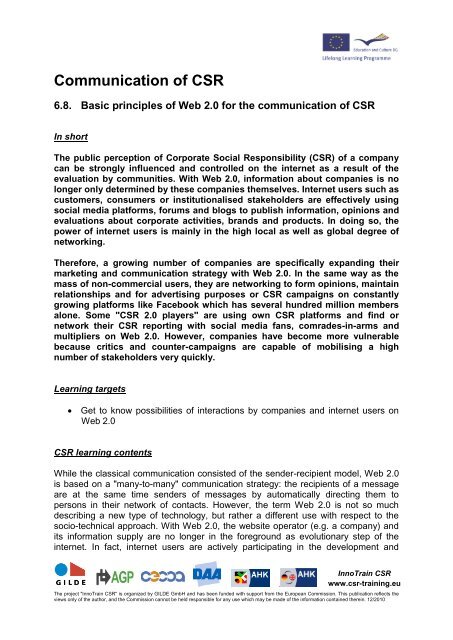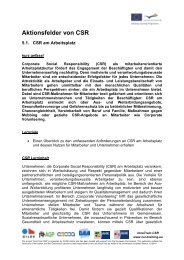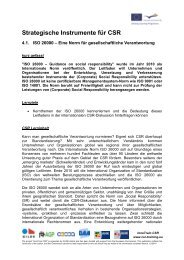What is Corporate Social Responsibility? - InnoTrain CSR
What is Corporate Social Responsibility? - InnoTrain CSR
What is Corporate Social Responsibility? - InnoTrain CSR
Create successful ePaper yourself
Turn your PDF publications into a flip-book with our unique Google optimized e-Paper software.
Communication of <strong>CSR</strong><br />
6.8. Basic principles of Web 2.0 for the communication of <strong>CSR</strong><br />
In short<br />
The public perception of <strong>Corporate</strong> <strong>Social</strong> <strong>Responsibility</strong> (<strong>CSR</strong>) of a company<br />
can be strongly influenced and controlled on the internet as a result of the<br />
evaluation by communities. With Web 2.0, information about companies <strong>is</strong> no<br />
longer only determined by these companies themselves. Internet users such as<br />
customers, consumers or institutional<strong>is</strong>ed stakeholders are effectively using<br />
social media platforms, forums and blogs to publ<strong>is</strong>h information, opinions and<br />
evaluations about corporate activities, brands and products. In doing so, the<br />
power of internet users <strong>is</strong> mainly in the high local as well as global degree of<br />
networking.<br />
Therefore, a growing number of companies are specifically expanding their<br />
marketing and communication strategy with Web 2.0. In the same way as the<br />
mass of non-commercial users, they are networking to form opinions, maintain<br />
relationships and for advert<strong>is</strong>ing purposes or <strong>CSR</strong> campaigns on constantly<br />
growing platforms like Facebook which has several hundred million members<br />
alone. Some "<strong>CSR</strong> 2.0 players" are using own <strong>CSR</strong> platforms and find or<br />
network their <strong>CSR</strong> reporting with social media fans, comrades-in-arms and<br />
multipliers on Web 2.0. However, companies have become more vulnerable<br />
because critics and counter-campaigns are capable of mobil<strong>is</strong>ing a high<br />
number of stakeholders very quickly.<br />
Learning targets<br />
� Get to know possibilities of interactions by companies and internet users on<br />
Web 2.0<br />
<strong>CSR</strong> learning contents<br />
While the classical communication cons<strong>is</strong>ted of the sender-recipient model, Web 2.0<br />
<strong>is</strong> based on a "many-to-many" communication strategy: the recipients of a message<br />
are at the same time senders of messages by automatically directing them to<br />
persons in their network of contacts. However, the term Web 2.0 <strong>is</strong> not so much<br />
describing a new type of technology, but rather a different use with respect to the<br />
socio-technical approach. With Web 2.0, the website operator (e.g. a company) and<br />
its information supply are no longer in the foreground as evolutionary step of the<br />
internet. In fact, internet users are actively participating in the development and<br />
The project "<strong>InnoTrain</strong> <strong>CSR</strong>" <strong>is</strong> organized by GILDE GmbH and has been funded with support from the European Comm<strong>is</strong>sion. Th<strong>is</strong> publication reflects the<br />
views only of the author, and the Comm<strong>is</strong>sion cannot be held responsible for any use which may be made of the information contained therein. 12/2010<br />
,<br />
<strong>InnoTrain</strong> <strong>CSR</strong><br />
www.csr-training.eu





